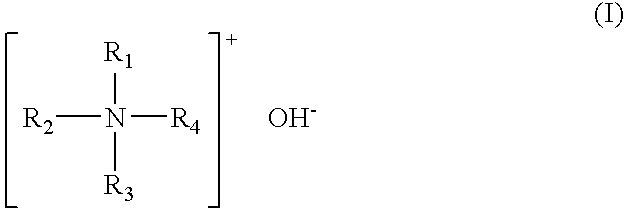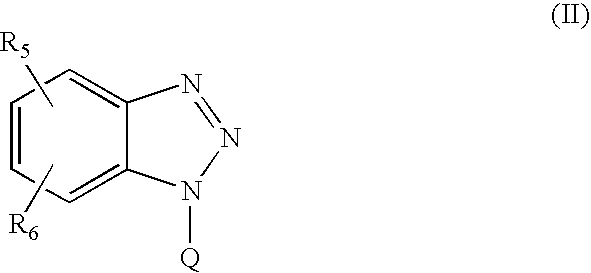Treating liquid for photoresist removal, and method for treating substrate
a technology of treating liquid and photoresist, which is applied in the direction of photomechanical treatment, photomechanical equipment, instruments, etc., can solve the problems of wiring delay, difficult to remove deteriorated films, and severe conditions, and achieve the effect of improving dissolution
- Summary
- Abstract
- Description
- Claims
- Application Information
AI Technical Summary
Benefits of technology
Problems solved by technology
Method used
Image
Examples
examples
[0069] The invention is described in more detail with reference to the following Examples, to which, however, the invention should not be limited. Unless otherwise specifically indicated, the amount is in terms of % by mass (substantial content, solid content). In Table 1, “PC” means propylene carbonate, and “PG” means propylene glycol.
1. Preparation of Photoresist-Stripping Liquid A:
[0070] A photoresist-stripping liquid A was prepared according to an ordinary method, containing 10% by mass of tetramethylammonium hydroxide (TMAH), 57.5% by mass of dimethylsulfoxide (DMSO), 30% by mass of water, 1.5% by mass of thioglycerol and 1.0% by mass of 2,2′-{[(4-methyl-1H-benzotriazol-1-yl)methyl]imino}bisethanol (=“IR42”).
2. Production of Dry-Etched Substrate:
[0071] A positive photoresist, TDUR-P722 (by Tokyo Ohka Kogyo Co., Ltd.) was applied to a substrate having copper wiring formed thereon and having an SiOC layer (carbon-doped oxide layer; low-k layer) formed on it, and heated at 1...
examples 1 to 4
[0073] After dry-etched in the manner as above, the substrate was dipped in a treating liquid shown in Table 1, at 50° C. for 20 minutes, and then rinsed with pure water.
[0074] The surface of the thus-treated substrate was observed with SEM (scanning electronic microscope), and evaluated according to the following criteria. The results are shown in Table 1. The low-dielectric layer was not corroded.
[Dissolution (For Promoted Removal) of Deteriorated Photoresist Film]
[0075]◯: Effective for promoted removal of deteriorated photoresist film.
[0076] X: Not effective for promoted removal of deteriorated photoresist film.
[0077] Next, the substrate was dipped in the photoresist-stripping liquid A, at 50° C. for 20 minutes. Next, this was rinsed with pure water and then dried.
[0078] The surface of the thus-treated substrate was observed with SEM (scanning electronic microscope), and evaluated according to the following criteria. The results are shown in Table 1. The low-dielectric laye...
PUM
 Login to View More
Login to View More Abstract
Description
Claims
Application Information
 Login to View More
Login to View More - R&D
- Intellectual Property
- Life Sciences
- Materials
- Tech Scout
- Unparalleled Data Quality
- Higher Quality Content
- 60% Fewer Hallucinations
Browse by: Latest US Patents, China's latest patents, Technical Efficacy Thesaurus, Application Domain, Technology Topic, Popular Technical Reports.
© 2025 PatSnap. All rights reserved.Legal|Privacy policy|Modern Slavery Act Transparency Statement|Sitemap|About US| Contact US: help@patsnap.com



